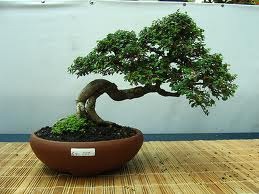 While pre-mixed soil for bonsai plants may be purchased at nurseries and garden stores, many bonsai enthusiasts seriously recommend steering clear of them. Bonsai are kept in a small amount of soil compared with other plants, and therefore special consideration must be given to the type of soil they are placed in. The plant is, after all, getting everything it needs, aside from sunlight, from the soil.
While pre-mixed soil for bonsai plants may be purchased at nurseries and garden stores, many bonsai enthusiasts seriously recommend steering clear of them. Bonsai are kept in a small amount of soil compared with other plants, and therefore special consideration must be given to the type of soil they are placed in. The plant is, after all, getting everything it needs, aside from sunlight, from the soil.
First, soil mix for Bonsai will need to properly breathe, as the root system of the plant will need access to oxygen. The soil should not be so dense as to not allow air to reach the roots. The second concern is water. The mix will need to both allow water to pass through it and drain out of the pot while also retaining enough moisture for the plant to not dry out between waterings. As with all things bonsai, a great deal depends on the species of plant. Fruiting or flowering plants require more water, and therefore a mix that will hold more water; while coniferous plants will not need as much water and do well with a mix that stresses water drainage.
Soil mixes can be organic or inorganic. Organic soil will be made from peat, mulch or other dead plant matter. Inorganic mixes will usually contain a type of baked clay or gravel. In the past, particularly among those in the west, it has been traditional to use some type of organic soil mix for bonsai. This attitude has change over the years, and now an inorganic type is considered best. The reason for this lies in the fact that the organic mixes will break down over time and become inconsistent with respect to water retention and aeration. The tendency of the mix to break down causes it to become too compact. When the soil is retaining too much water and not getting enough air, it will cause the roots to potentially rot and the threaten the health of the plant.
Inorganic soil mixes, however, do not have the same tendency to break down. They are essentially pellets of clay that have been fired or baked. In Japan, bonsai enthusiasts will use a baked clay substance called Akadama, which is relatively inexpensive and attainable there. While Akadama is exported to the rest of the world, its price may be prohibitive and may only be obtainable from specialty stores. Many bonsai hobbyists outside of Japan, however, have found common cat litter to be equally effective. There are, however, many different sorts of cat litter, and experimentation and research may be required to find the best suited for bonsai. What is need is called "freshwater Diatomaceous Earth" or "Diatomite". Whatever is used, it is important the the clay used be fired, as unbaked clay will congeal when wet and eventually break down. It also may be necessary with inorganic soil mixes to sift or wash the soil to remove dust.
Again, plant species and geographic location must be taken into account when choosing a soil mix. Asking at a bonsai nursery or finding other enthusiasts in one’s area will give a good idea as to what to use.

Deprecated: strpos(): Passing null to parameter #1 ($haystack) of type string is deprecated in /home/agriviek8Qv/agriviet.net/public_html/wp-includes/comment-template.php on line 2522